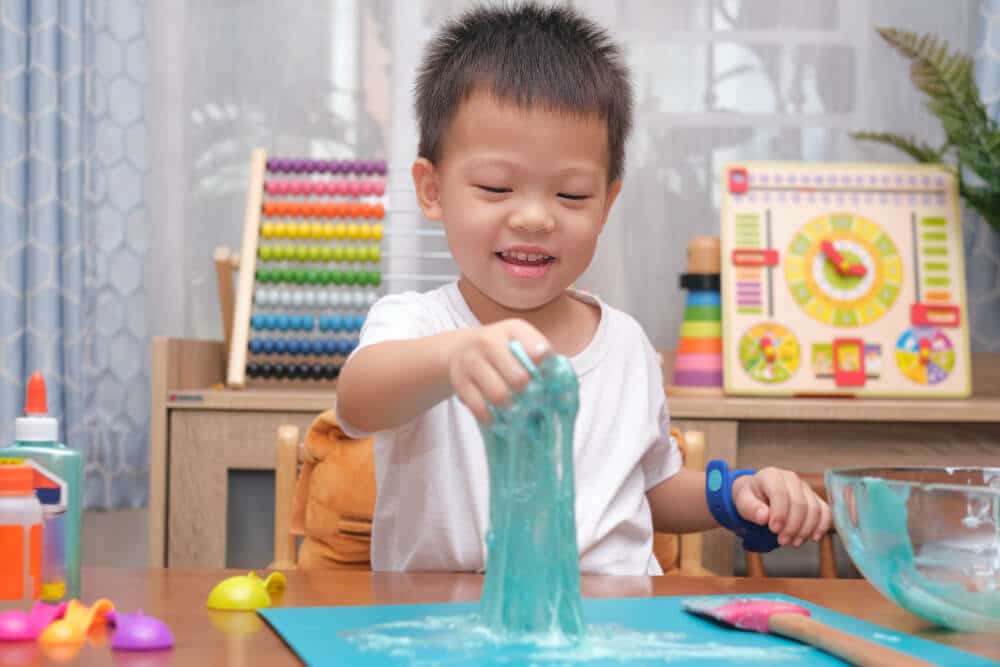When we hear about strategies for language development, some of the most engaging activities involve play. One of my favorites is sensory play for language development. There are so many ways to target speech and language goals, such as new vocabulary, expanding phrases, targeting age-appropriate concepts, following directions, and social pragmatic skills, to name a few.
This blog post will share some of our favorite sensory activities that are easy to set up at home!
What is Sensory Play?
Sensory play consists of activities that engage a child’s senses such as touch, taste, smell, sight, and hearing. This is a natural way for children to explore scientific processes while they play and investigate new sensations (Famlii, 2018). Sensory play targets several aspects of a child’s development including motor skills, speech, and language, nerve connections in the brain, problem-solving, and mindfulness (Exploring the Benefits of Sensory Play, 2018).
Some of my favorite sensory play includes touch or tactile play which can include slime, sand, kinetic sand, or shaving cream. The sensory play lends itself to building vocabulary in deeper, more meaningful ways, as we can use a host of different words such as adjectives and In addition, sensory bins can be made with containers of all different sizes using beans, rice, pasta, and other textures commonly found in the home. Sensory bins can be made around themes such as the seasons and holidays to build language skills.
Sensory play can be used to facilitate these skills for all ages. For infants, sensory play can include bubbles as children feel them land on their skin, pop the bubbles, etc. This also promotes joint attention and sustained attention. For toddlers, finger painting is a great way to learn about colors, create shapes, and experiment with mixing colors, etc. For preschool-aged children sensory play can be used to support the learning of early academic concepts, as well as build a deeper understanding of vocabulary by describing features of items by describing what things look like, how they feel, their parts, what they are used for, where they are found, etc. (Exploring the Benefits of Sensory Play, 2018).
Implementing Sensory Play
There are so many ways to target speech and language goals with sensory play. You can target vocabulary and lexicon expansion with the use of new terms and modeling descriptive words with your child e.g. “squishy, slimy, shiny, etc”. You can target speech sounds and expansion of utterances as you encourage them to use longer phrases by recasting or adding more detail to their phrases.
For example, if your child says “slime” you can respond with “yes, slime is stretchy.” Receptive language can be targeted by asking “why” questions, such as. “What does it feel like? Or “What color is it”. You can also target concepts/ directions, by emphasizing certain words in play such as “put the sand on top, put the sand in the bucket, pull apart the slime”.
Other areas that can be targeted with sensory play are building pretend play skills, self-regulation strategies, cognitive flexibility, and enriching new experiences (Allisonfors, 2021). Sensory play also allows for targeting higher-level language skills such as inferencing and problem solving with questions such as “What do we need for a sandcastle? How do you think this was made?”
Key Takeaway
Overall, sensory play is an excellent way to engage your child and foster important skills for child development. Sensory play can support motor development, attention, problem-solving, and especially speech and language skills. Most importantly, your child will be engaged in a fun activity while learning about the world around them, which is why at Kidsense Therapy Group, we love to include sensory play in our treatment sessions.
For more advice, tips, and professional insight into Speech and Language Therapy, explore our related blog articles here.
References
Allisonfors. (2021, January 10). Why You Should Be Using Sensory Play in Speech Therapy. Retrieved from https://allisonfors.com/sensory-play-speech-therapy/
Exploring the benefits of sensory play. (2018, March 12). Retrieved from https://www.goodstart.org.au/news-and-advice/october-2016/exploring-the-benefits-of-sensory-play
Famlii. (2018, February 25). What is Sensory Play? Retrieved from https://www.famlii.com/what-is-sensory-play/

